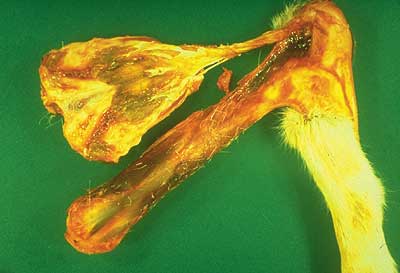Parasites and Diseases
Exertional Myopathy
A Field Guide
TO COMMON WILDLIFE DISEASES
AND PARASITES IN ALASKA
EXERTIONAL MYOPATHY

Shoulder blade and leg of Dall Sheep. Diminished muscles due to myopathy.
| What causes exertional myopathy? |
- Exertional myopathy is a muscle disease that can occur when wild animals are chased, handled or stressed.
| Where does exertional myopathy occur? |
- It is most commonly seen in ungulates (hoofed animals) like moose and caribou, but has been reported in a wide variety of wild animals and birds.
- It can occur whenever animals are chased or handled.
| What are the signs of exertional myopathy? |
- Animals may appear depressed, weak and stiff.
- The muscles, heart and kidney are usually affected but signs may be difficult to see.
- There may be differences in the color and textures of muscle groups.
- Early in the disease, affected muscles may look wet and have small bruises.
- Later, the muscle becomes pale, dry, and very soft.
- In severe cases, entire muscles may be torn.
- The heart muscle may have pale areas or streaks.
- Lungs are usually dark and wet.
- In bad cases, the bladder may contain red-brown urine and kidneys may be dark brown.
| Can I eat the meat? |
- Meat from affected animals is suitable for human consumption.
- Exertional myopathy may cause muscle changes that decrease the quality of the meat.
| Samples to collect |
- Portions of muscle from several different areas of the body, as well as sections of the heart and kidney.
- Samples should be kept cool but not frozen.
- To report an occurrence or to submit a sample for identification/analysis, contact the DWC Wildlife Disease Surveillance reporting hotline 907-328-8354, send an email to dfg.dwc.vet@alaska.gov or visit your local ADF&G office.
